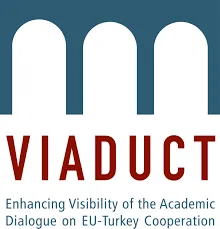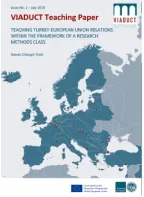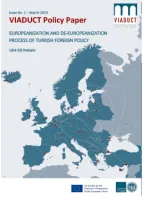VIADUCT
Enhancing visibility of the Academic Dialogue on EU-Turkey Cooperation
VIADUCT’s promotes research, teaching and policy dialogue on EU-Turkey relations

The historical complexity and volatility of EU-Turkey relations are reflected by research and teaching in this field. There are international research projects as well as many smaller and nationally funded studies and projects dealing with Turkey, including its relationship with the EU. Linking these different projects, diffusing knowledge on the European Integration process and exploiting synergies between international players constitutes real added-value for European Integration studies.
To this end, VIADUCT builds a large network with partner institutions in every EU member state, Turkey and the neighbourhood extending its outreach in research and teaching beyond the EU.
The VIADUCT network comprises of 40 partner institutions and one extended network partner from 36 countries.
The Challenge faced by the VIADUCT Partners are the EU Turkey relations as a moving target. On the one hand Turkey is seen as a “key strategic partner for the EU”, on the other hand several interconnected crises are profoundly affecting EU–Turkey relations.
VIADUCT’s objective is, hence, to promote research, teaching and policy dialogue on EU-Turkey relations. To do so, VIADUCT uses a 4 x 4 approach.
1. The Four-I Strategy: Intergenerationality, Interdisciplinarity, Internationality, Intertemporality
- Intergenerationality: linking young researchers with experienced researchers/practitioners;
- Interdisciplinarity: bringing together researchers from multiple disciplines;
- Internationality: involving 40+1 universities and thinks tanks based in all 28 EU member states, Turkey, and 7 neighbouring countries;
- Intertemporality: using historic narratives and scenarios to explain the most prevalent present problems.
2. Four possible future scenarios of EU-Turkey relations: reference points for VIADUCT research, teaching and policy dialogue
- Scenario 1: Managing the fragile status quo.
- Scenario 2: Upgrading existing forms of cooperation.
- Scenario 3: Reactivating the accession process.
- Scenario 4: Dealing with a difficult or even hostile neighbour.
3. The four cross-sectorial issues: multidisciplinary synergies
- Power: Politics and Security
- Resources: Economics and Energy
- People: Migration and Identity
- Future of the EU: new forms of relations between an EU-27 with neighbouring countries
4. Four dimensions of activities
- Face-to-Face-Meetings during three 'VIADUCT weeks
- Online Exchange and Dissemination Platforms
- Publications
- Multiplication
Follow us on Facebook and Twitter
Partners:
Coordinator: University of Cologne
- Cambridge University
- Charles University Prague
- Hellenic Foundation for European and Foreign Policy (ELIAMEP)
- ETH Zürich
- The Finnish Institute of International Affairs (FIIA)
- HU Berlin
- Institut für Europäische Politik e.V (IEP)
- Sciences Po Grenoble
- University of Luxemburg
- Maastricht University
- Sabanci University
- Trans European Policy Studies Association (TEPSA)
- University College Dublin
- Vilnius University
- Webster University Vienna
- Centre for European Studies University of Oslo (ARENA)
- The American University in Cairo
- Barcelona Centre for International Affairs (CIDOB)
- Romanian Center for European Policies (CRPE)
- Danish Institute for International Studies (DIIS)
- Istituto Affari Internazioanli (IAI)
- Comenius University Bratislava (IESIR)
- University of Iceland
- Georgian Foundation for International Studies (GFSIS)
- IRMO Zagreb
- Institute for World Economics (IWE)
- Latvian Institute of International Affairs Riga
- Middle East Research Institute (MERI)
- Middle East Technical University
- Plovdiv University
- Swedish Institute for International Affairs
- Turkish-German University
- Tel Aviv University
- University of Nicosia
- University of Ljubljana
- Universidade Nova de Lisboa
- University of Malta
- University of Tartu
- Koc University
- College of Europe - Natolin Campus




